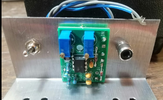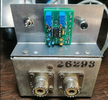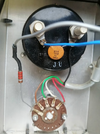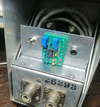One of the 1st pieces of equipment I bought when I got into CBing in the late 60s was my trusty Drake W-4 wattmeter. Over 60 years old and still works and looks like new. Only downside . . . AVG reading only, no PEP.
I ran across a site online from K4DPK offering a PEP conversion kit for the W-4. The price was right, so I thought I'd give it a shot and bought it. Received it yesterday. Nicely built and GREAT instructions.

The kit is designed to bolt on to two existing screw holes on the W-4s sensor box.

I removed the box (4 screws) and installed the PEP kit. Cut a wire on the W-4 and spliced in the wires from the PEP kit.

The kit requires an 8 - 14 vdc supply. I chose to use a rechargeable 9 volt battery.
I have enough wires running around my station.
Reassembled the meter, hooked it up, and it was ready to go. Easy calibration. and "hang time" adjustment.

PEP/AVG W-4 works perfectly. Easy 45 minutes work.
- 399
I ran across a site online from K4DPK offering a PEP conversion kit for the W-4. The price was right, so I thought I'd give it a shot and bought it. Received it yesterday. Nicely built and GREAT instructions.

The kit is designed to bolt on to two existing screw holes on the W-4s sensor box.

I removed the box (4 screws) and installed the PEP kit. Cut a wire on the W-4 and spliced in the wires from the PEP kit.

The kit requires an 8 - 14 vdc supply. I chose to use a rechargeable 9 volt battery.
I have enough wires running around my station.
Reassembled the meter, hooked it up, and it was ready to go. Easy calibration. and "hang time" adjustment.

PEP/AVG W-4 works perfectly. Easy 45 minutes work.
- 399
Last edited:
